John Hurrell – 21 October, 2019
One of the pleasures of this installation is walking around, behind (and in front of) the large sculptures, and between them and the giant wall drawing, watching the large forms change (peering through) and circumnavigating the small objects on the floor. Also in comparing the intricate patterns of the woven ochre fabric (both sides) and the complex tape configuration, as its distant diagonal sides slowly descend to vanishing points far away from the central corner hinge.
Christchurch
Kate Scardifield
The Lighter A Thought The More It Rises
14 September - 24 November 2019
Upstairs in CoCA’s large Mair Gallery, the Australian artist Kate Scardifield presents a dramatic iteration of a work earlier presented in a Sydney College of the Arts gallery that was originally a building used for the washing, drying and airing of large quantities of cloth.
The Christchurch installation is spatially divided up into three components; a long dark blue gridded steel rack on which is draped a long swathe of finely woven yellow ochre fabric; a yacht sail (suspended on pullies from the ceiling) on which is attached sliced and pleated silk ribbon; plus a huge gridded wall drawing (two massive triangles that meet in a corner) that mimics an intricate gridded dressmaker’s cutting board, and is made of parallel lines of masking tape with loosely hanging (still attached) paper rolls.
All three elements are interconnected. The repeated grid module (its exact measurements) is common to both the drying rack and the delicate (but massive) wall drawing. The wide metal rack with its draped fabric can be seen as a kind of (boatless) sail that connects with the other scrunched-up crumpled sail hanging from the high stud.
Scardifield‘s soaring project seems to tease out the airy associations of the colour pale (sky) blue, and at times, watery ones too, with the collapsed sail looking like a jellyfish with red tentacles, and the wall drawing’s upper diagonal edges looking like lurching horizon lines. The bunched-up ochre fabric could be the curling edges of waves pushing against the breezes alluded to by the other sail’s vertical red ribbons.
Gravity is referenced too, with the taut pulley ropes tied to metal plates resting on compressed fabric blocks. Heavy cloth bags (loaded with sand) colourful with handles, also hint at imagined muscular participation. Strangely, even the immense concrete floor of the Mair gallery starts to feel like a floating raft or deck.
One of the pleasures of this installation is walking around, behind (and in front of) the large sculptures, and between them and the giant wall drawing, watching the large forms change (peering through) and circumnavigating the small objects on the floor; also, in comparing the intricate patterns of the woven ochre fabric (both sides) and the complex tape configuration, as its distant diagonal sides slowly descend to vanishing points far away from the central corner hinge.
With the two versions of the same grid—and the references to navigation—you could argue that this show (in a restrained minimalist sense) alludes to nineteenth century cartography and the mechanisms of mapping. And the woven cloth to the crisscrossing nautical routes of trade.
Here Scardifield creates a rich ‘poetry’, without clutter, one that is bodily sensitive while being full of historical references. The calculatedly ambiguous and layered show looks effortless: a considerable achievement in such a large venue; and a treat for local Cantabrians.
John Hurrell
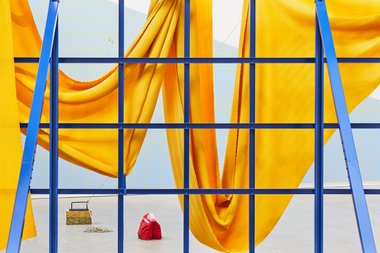
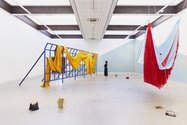
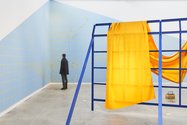
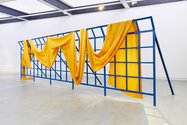


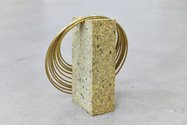
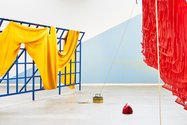
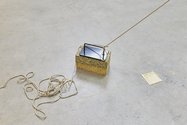
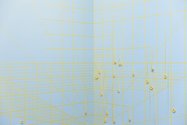
 Advertising in this column
Advertising in this column Two Rooms presents a program of residencies and projects
Two Rooms presents a program of residencies and projects



This Discussion has 0 comments.
Comment
Participate
Register to Participate.
Sign in
Sign in to an existing account.